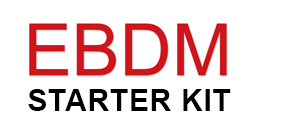EBDM Starter Kit
7a: Developing a Communications Strategy; Building Stakeholder and Community Engagement
Navigating the Roadmap

Activity 7: Engage/gain the support of the community.
Introduction
The EBDM Initiative seeks to create a set of conditions under which harm and risk reduction are realized to their true potential. Agreement on a systemwide vision and methods to assess its achievement, collaboration at the policy level, and careful analysis and application of the research in ways that ensure evidence-based decision making and practice are all important but insufficient to the achievement of desired outcomes. Without the understanding and “buy-in” of stakeholders—both within the system and, as importantly, in the public—change of the order described in the Framework is unlikely to take root and flourish.
Purpose
Broadly, the purpose of developing a communications strategy is to facilitate understanding of, and support for, evidence-based decision making policies and approaches. The specific aims of a jurisdiction’s communications plan include the following:
- To raise awareness and educate stakeholders about the value of evidence-based decision making as an enhancement to existing justice system practices.
- To engage interest in, and support for, such an approach among those who oversee, work within, interact with, and/or are affected by the local criminal justice system.
- To engage stakeholders in a purposeful way in the identification and/or implementation of harm reduction strategies that will support healthier communities.
Participants
This document was developed for EBDM policy teams (and/or their work groups) to advance their efforts to engage stakeholders—both internal and external to the justice system—in the EBDM Initiative and in jurisdictions’ broad harm reduction goals.
Instructions
To begin, consider the following questions to ensure a thorough understanding of the place from which your communications planning effort is starting:
Adopting a Consistent Message
While Milwaukee County, Wisconsin’s communication plan involves outreach to a variety of audiences, including business leaders, citizens, elected officials, educators, and the media, a consistent message is communicated:
Our commitment to the discipline of EBDM will enable us to hold offenders accountable, reduce the overall crime rate and recidivism, and give taxpayers a better return on the dollars they invest in criminal justice.
- Who are the audiences you are trying to reach? Consider those within the local and perhaps state justice system (e.g., policymakers, supervisors, and/or staff) and audiences external to the justice system (e.g., community leaders, the general public).
- What information are they currently receiving?
- Who communicates with these audiences regarding justice-system related matters in an official communications capacity (e.g., public information officers) and/or as part of their role (e.g., chiefs of police or district attorneys conduct routine roundtables with civic groups; probation officers and detectives are members of ad hoc public education committees that educate communities on offender reentry issues)?
- For each audience identified, think about (and perhaps create a matrix that identifies) the following:
- What are the one or two primary ways to reach each audience (e.g., newspaper article, radio broadcast, speech, on the Web)?
- What do you want each audience to know?
- What is their current base of knowledge—that is, where are you starting from? Is this a well-informed audience?
- What is the audience’s perspective? For example, does this audience have a positive viewpoint on the topics you want to discuss?
- Who is best positioned to communicate with this audience, and how?
- In what ways are current communication efforts working effectively?
- In what ways could or should these efforts be expanded?
- Based upon the answers to these questions, and after reviewing the “Tips” section below, build an action plan for your communications strategy. It may include specific, one-time events for specific audiences (e.g., a presentation to the business leaders’ quarterly network meeting; a briefing of justice system professional staff on the EBDM Initiative) or a series of events for various audiences (e.g., a series of briefings over the course of six months with three specifically identified local journalists; a series of training events on specific topics for a multidisciplinary group of professional staff). It will likely include a mix of long-term, big-picture topics (e.g., how the justice system operates, strategic action plans being developed or underway) and specific event-related strategies (e.g., highlighting the story of an offender who successfully completed supervision, launching a new program or policy approach).
Tips
Grant County, Indiana’s Core Message
EBDM is the thoughtful stewardship of the public’s money and trust in operating an efficient and effective criminal justice system.
One less offender.
One less victim.
- Consider crafting a set of communications messages. Possible examples include the following:
- Our communities can do better (than a 67% failure rate); we can create safer communities; we can reduce harm; we can have fewer crimes and fewer victims.
- A local criminal justice system informed by research can point the way because it places the highest premium on outcomes, on the individual and institutional actions that produce them, and on the careful, ongoing measurement of them.
- An evidence-based approach should not replace discretion and judgment, but it can inform and guide that judgment to enhance the likelihood that desired outcomes will be achieved.
- A common local vision, internal collaboration, interagency partnership, public involvement, and shared responsibility are indispensable building blocks for alleviating community harm.
- Consider developing an identity. One resource is provided by the national EBDM Initiative team; jurisdictions may choose to adopt this identity or to develop their own.
- The national EBDM Initiative team created an “interactive” graphic that encourages decision makers to “complete” its concept with one or more words capturing the forms of harm they, their staffs, and their communities most desire to reduce (i.e., the phrase “One less _____” accompanied by “A strategy for safer communities” as its tagline). The graphic was designed to stand alone as a deliberately incomplete thought to pique curiosity or, for particular audiences, to be filled in with words such as “victim,” “crime,” “inmate,” “offender,” “dollar spent,” “officer injured,” or “court case.”
- Consider developing communications tools and materials, for example:
- a scripted “elevator speech” incorporating the key messages. (An “elevator speech” is an overview of an idea for a product, service, or project. The name reflects the fact that it should be possible to deliver the speech in the time it would take for an elevator ride, that is, approximately 30 seconds.)
- local criminal- and victim-focused case stories that have strong emotional impact.
- well-designed, appealing pamphlets that replicate the elevator speech in bullet form and include human interest stories.
- video clips by local champions that illuminate the aspirations of local policymakers, specific approaches or challenges, etc.
- a presentation of the overall project to be used at stakeholders’ meetings (i.e., a core set of slides augmented by stakeholder-specific slides and jurisdictional findings from the assessment phase). The EBDM Initiative team has developed a “core training curriculum,” available on SharePoint, that can be tailored for local purposes.
- stakeholder-specific material for staff on the elements of the Framework and the jurisdiction’s implementation plan that is applicable to their role in the justice system.
- training materials for line staff that tie specific policy and procedure changes to specific research supporting such changes.
- print communications (e.g., posters, banners, brochures, progress reports) directed at staff and displayed in offices. Examples include a “One Less” brochure or “One Less” posters that feature the name and photo of EBDM policy team members and their “One Less” aspirations. (See an example below.)
- promotional items and giveaways for staff (e.g., t-shirts, coffee mugs, and/or pens) that encourage the Initiative and remind and excite staff about change.
- Consider conducting a public opinion survey and/or focus groups.
National Survey on EBDM
In Phase I of the EBDM Initiative, the national Initiative team worked with Zogby International to develop and administer a national public opinion survey.
This tested survey offers a model that could be replicated at the local level and a set of findings against which local results can be compared. If the data align with the findings of the national poll, they will provide the impetus, as well as political coverage, for difficult decisions. Even in the event that the data do not align with national findings, they will become an integral part of the development of local messages.
A fact sheet that summarizes the findings of the national public opinion survey can be found here: fact sheet
- Conduct a public opinion survey that measures citizens’ opinions on the justice system, its purpose, and the extent to which the system should rely on research, and citizens’ satisfaction with current justice system outcomes. For a list of questions that were used in a national survey, see the Appendix.
- Using subject matter experts, convene focus groups with the general public to better understand their views on matters related to the justice system and evidence-based decision making and/or as a means to effectively communicate with and engage citizens on these matters.
- Consider the development of a deliberate and purposeful public communications strategy using the media and other means.
- Prepare news releases and Op-Ed pieces; talking points for speeches at local gatherings, professional conferences, radio talk or call-in shows, news conferences, one-on-one meetings and open houses at stakeholders’ offices, newspaper editorial board meetings, etc.; public service announcements; and print communications campaigns (e.g., posters, brochures, press kits, web-based reports).
- Understand the research and collect data.
- Examine the research on effective communication strategies and campaigns to determine how this body of knowledge can best inform and shape your own efforts.
- Collect qualitative and quantitative information to determine the extent to which your communications tools and methods accomplish their intended purpose. One qualitative method of measurement would be to conduct a series of focus groups with local system stakeholders and the general public. Quantitative methods of measurement would involve pre- and post-testing of training modules, pre- and post-measurements of staff attitudes, or a fuller use of local public opinion polling. One possible strategy is to conduct a baseline poll at the launch of the communications strategy and then a second poll at a specified date in the future to measure change in both public and staff attitudes.
Examples
Charlottesville-Albemarle County, Virginia, EBDM Initiative Flyer
Eau Claire County, Wisconsin, Article in Rotary Club Newsletter, January 10, 2011
Charlottesville-Albemarle County, Virginia, “What One Less Means to Me” Marketing Tool
Ramsey County, Minnesota, EBDM Brochure
Additional Resources and Readings
See http://media.csosa.gov for an example of one jurisdiction’s efforts to communicate with stakeholders.
See http://ebdmoneless.org for a web page your local jurisdiction can link to, build upon, and/or replicate.
Appendix
EBDM Public Opinion Survey Questions
PDF/Printer Friendly Version of Section

